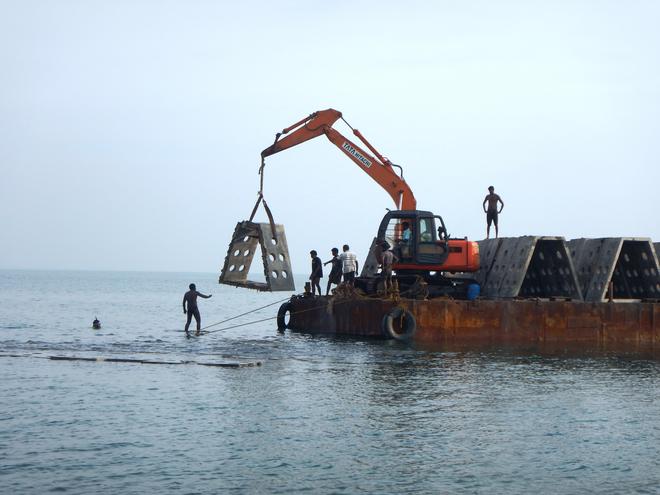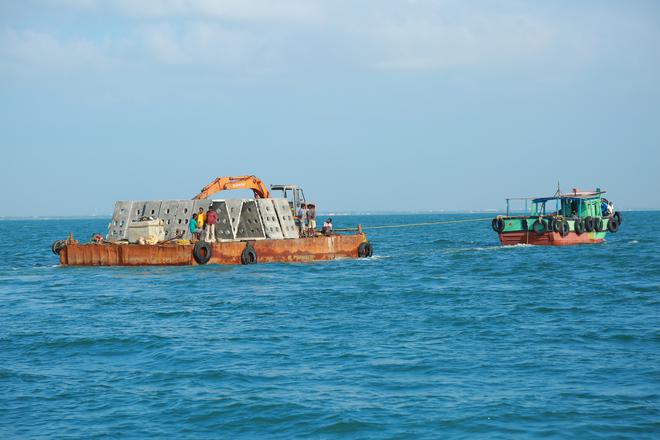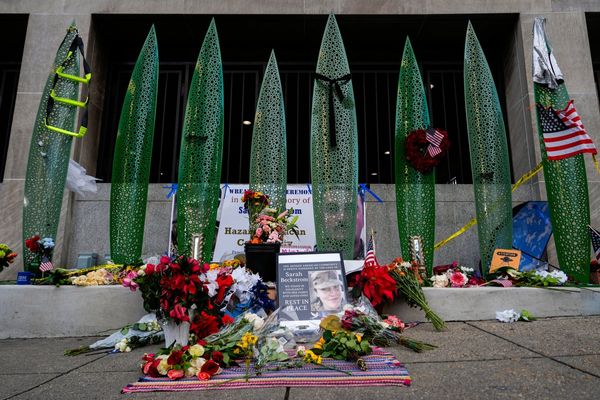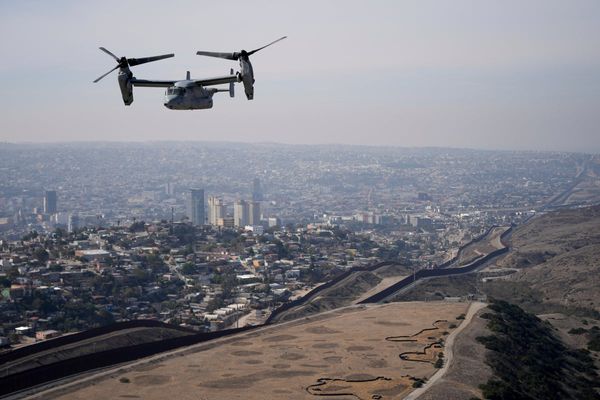

How do you save a vanishing island? Well, Tamil Nadu has already saved one and is set to save another in the next four years in the Gulf of Mannar. The Gulf is the country’s first marine biosphere and has innumerable jewels that adorn it. The crown was a set of 23 islands that dot the southern coast of Tamil Nadu, between the holy town of Rameswaram and the pearl city Thoothukudi.
Of these islands, two are already submerged. The combined efforts of the government and marine scientists have saved Vaan Island, which had split and was on the verge of submerging. After the intervention, the island is limping back to its original life, after more than 10,000 artificial reef modules were placed on the ocean floor.
Satisfied with the Vaan Island success, the State government has decided to save another island, Kariyachalli, the fourth in the line on the Thoothukudi side. “The government has passed an order to restore Kariyachalli [at a cost of ₹50 crore] as part of the Tamil Nadu Coastal Restoration Mission. The restoration of this island will be taken in the 2024-25 fiscal,” says Jagdish S. Bakan, Wildlife Warden, Gulf of Mannar Marine National Park. “The groundwork has been completed. We are in discussion with the World Bank. The proposal was for restoration of the Kariyachalli and Kasuwari Islands. They have accepted Kariyachalli for now. The island used to be 16 hectares, but has shrunk to 5.97 hectares,” he says.
Studies have predicted that without intervention, both the Kariyachalli and Kasuwari Islands will sink by 2035. Like last time, global tenders will be floated and the work could take up to three years, says Mr. Bakan, who won the UNESCO Michel Batisse Award and the UNEP Asia Environmental Enforcement Award in 2023 for his work in the biosphere.
Coral mining
The Gulf of Mannar has a chain of 21 low-lying uninhabited coral-reef islands. Over 4,300 species of flora and fauna have been recorded so far. Among them are 132 coral species. For more than a century, boulders and branching coral species in the Gulf of Mannar were extensively exploited for building materials and chemical industries.
The corals surrounding these islands are full of life and the locals knew it but in a crazy couple of decades in the late 20th Century, the local mafia, probably with the help of authorities, cleaned them up. Mining of coral reef removed the hard substrates, and the shores of the islands have been exposed to direct assault of wave action, leading to erosion. So far, two islands have submerged and the area of fifteen of them has come down.
Severe soil erosion
Vaan Island is one of the 21 islands located about 6 km off Thoothukudi. It is a low-lying island with small-scale sand dunes, mostly composed of reef sediments. The fringing type of coral reefs occurs around this island. The island suffered a severe soil erosion owing to the rampant coral mining until 2005 and the sea-level rise because of climate change. In 1969, the island was about 20.08 hectares. The area decreased to 16 hectares, according to the Marine National Park Notification, 1986. It further came down to 13.53 hectares in 2001 and 8.05 hectares in 2009. Then, it split in two halves. The northern part submerged during May 2015, and the southern area dwindled to 2.33/1.53 hectares during low tide and high tide respectively in December 2015, recalls Edward Patterson, director, Suganthi Devadason Marine Research Institute (SDMRI).
Taking into consideration the design of the earlier triangular artificial reef modules used for biodiversity enhancement and fishery production in the Gulf by SDMRI and based on the fine resolution bathymetry and wave dynamic studies conducted by the Indian Institute of Technology Madras (IIT-M), perforated multi-purpose trapezoidal artificial reef modules were constructed. The design would ensure protection, and enhance biodiversity and fish production. With longitudinal length, height, width and crest length of 1 metre, 2 metre, 2.5 metre respectively, the modules were constructed with ferro-cement and steel reinforcement (8 mm and 12 mm). Holes with diameters of 12 cm and 18 cm were made on the sides to create vortexes around the artificial reefs for the flushing of nutrients to organisms attached to them.
The modules (each weighing about 1.8 tonnes) were lifted with cranes and transferred by lorries to the seashore. Then by a small barge, the modules were transported to Vaan Island for deployment. At the deployment site, cranes on the barge placed the modules in the respective places accurately with the assistance from scuba divers.
Over 10,000 modules
The flat top of the artificial reefs facilitates the dissipation of energy and provides more space for the attachment of organisms. Altogether 10,600 modules were deployed in two rows, the inner row consisting of 16 clusters (400 in each cluster) and the outer row of 15 clusters (280 in each), with an interval of 20 metres between them. The deployment was carried out from December 2015 to February 2019. The trapezoidal artificial reefs are efficient in dissipating wave energy and encouraging deposition of sediments, leading to the formation of a spit on the northwest side of the island, which was exposed during low tide, Mr. Patterson said.
As a result, the area of the island increased to 3.79 hectares (low tide) and 1.71 hectares (high tide) in September 2023. Though the island size remains at 3-4 hectares in the recent time, there are noted changes in bathymetry. The waters around the spit have become shallower, with a reduction from 2.5 metres to 0.5 metre between 2015 and 2023, an indication of exposure of more land in the future, which may stabilise in a few years, he said.
The larger population of coral recruits of over 37 species in the artificial reefs may ultimately act as biological sediment factories for the stabilisation of the island. The multiple rows and holes in the artificial reefs allow smaller and larger fishes to escape from predators. The increased density and richness of fishes at the artificial reef sites indicate that the role of the custom-designed artificial reefs in fishery enhancement is as effective as that of other artificial reefs worldwide.
As the artificial reef site is located inside the Marine Park, it is protected from direct fishing, say officials of the Forest Department. Artificial reef modules could help in increasing the biodiversity in the particular coral diversity and fishery potential of the area. The restoration of the Vaan Island helps in the protection of the nearby mainland coast from erosion, biodiversity conservation and livelihood support through enhanced fish production.
“In the changing climatic scenario with various factors threatening environment, biodiversity and dependent livelihood, this successful model is yet another hope in the coastal ecosystem restoration to protect our coast, to conserve the biodiversity, and to enhance the livelihood of dependent fisherfolk,” Mr. Patterson said.







